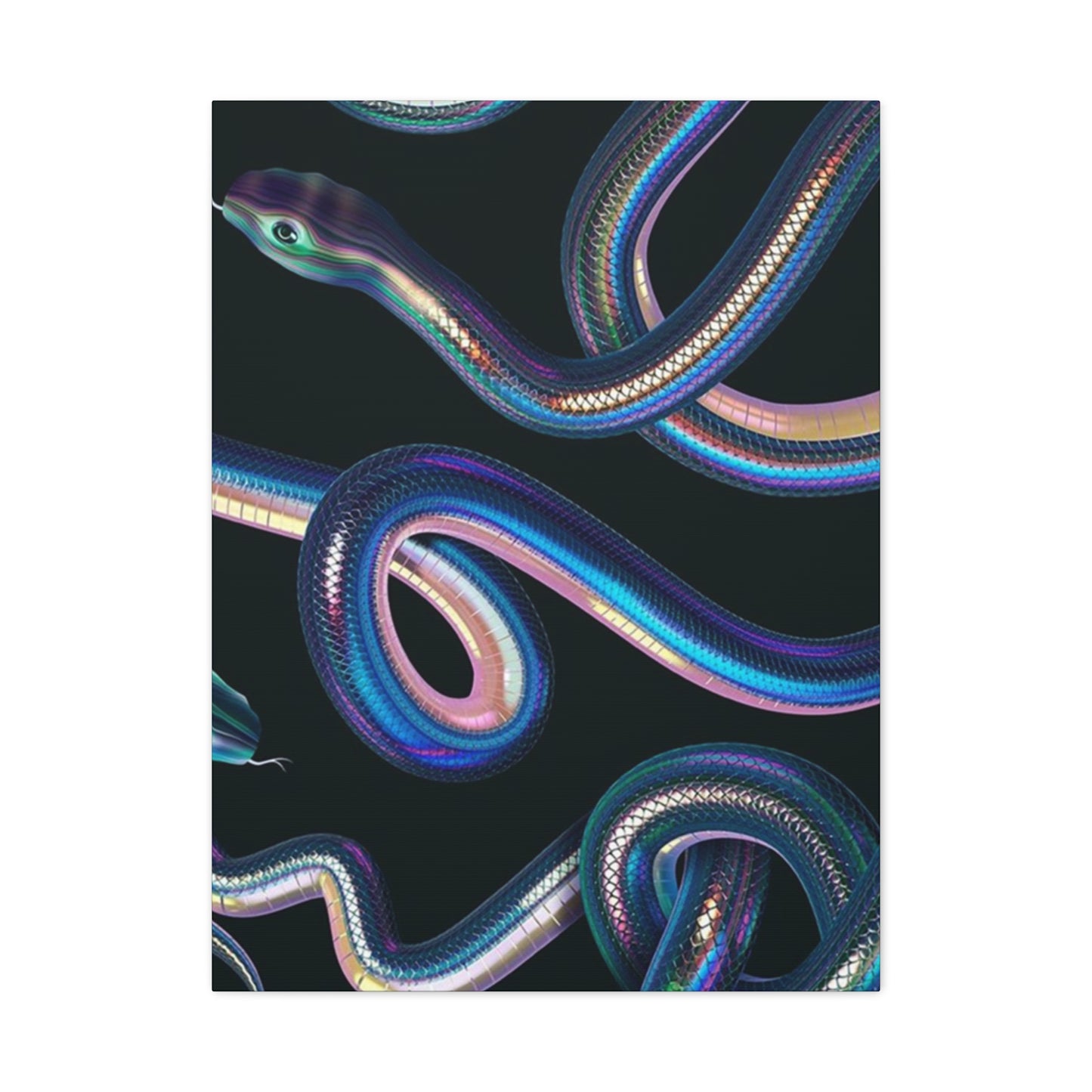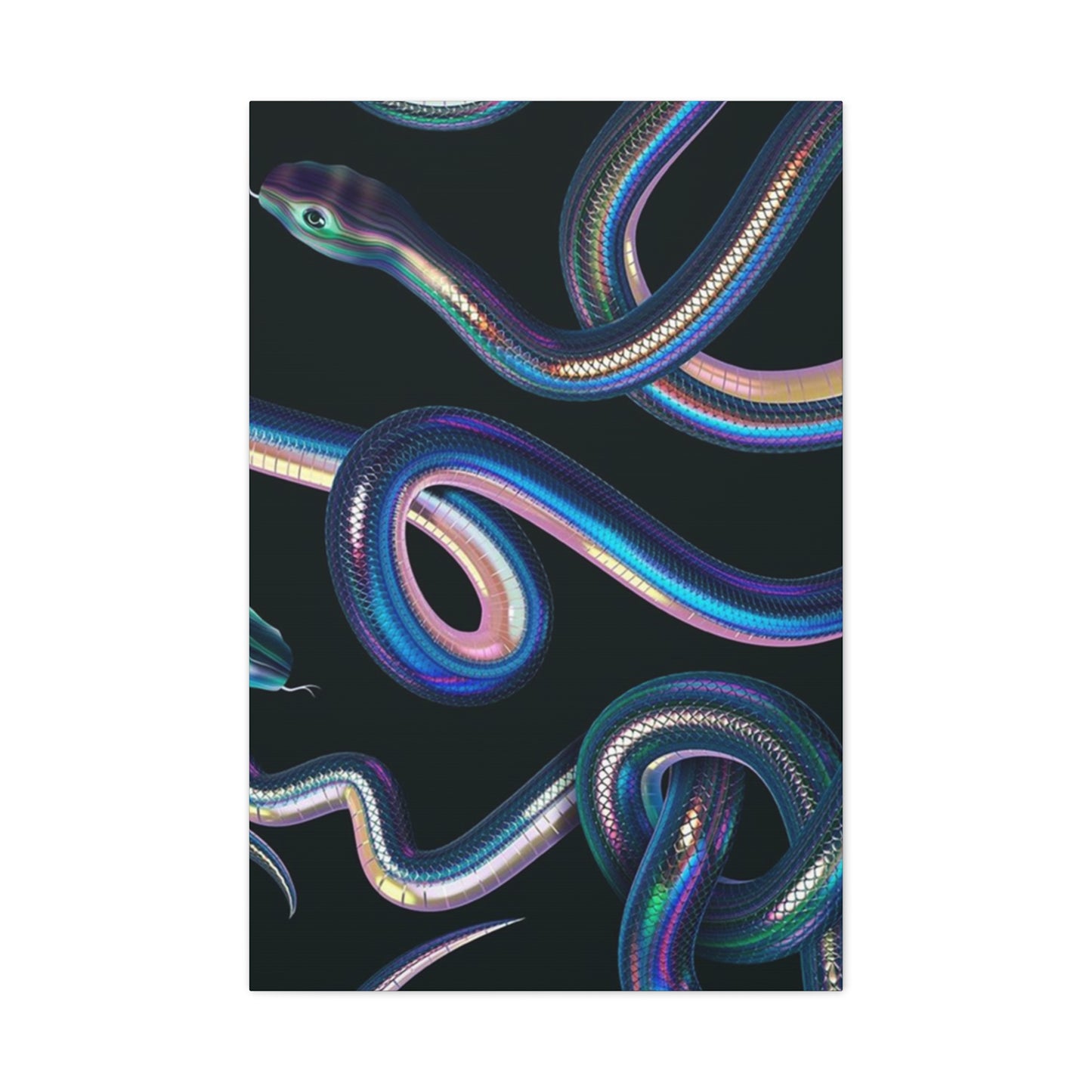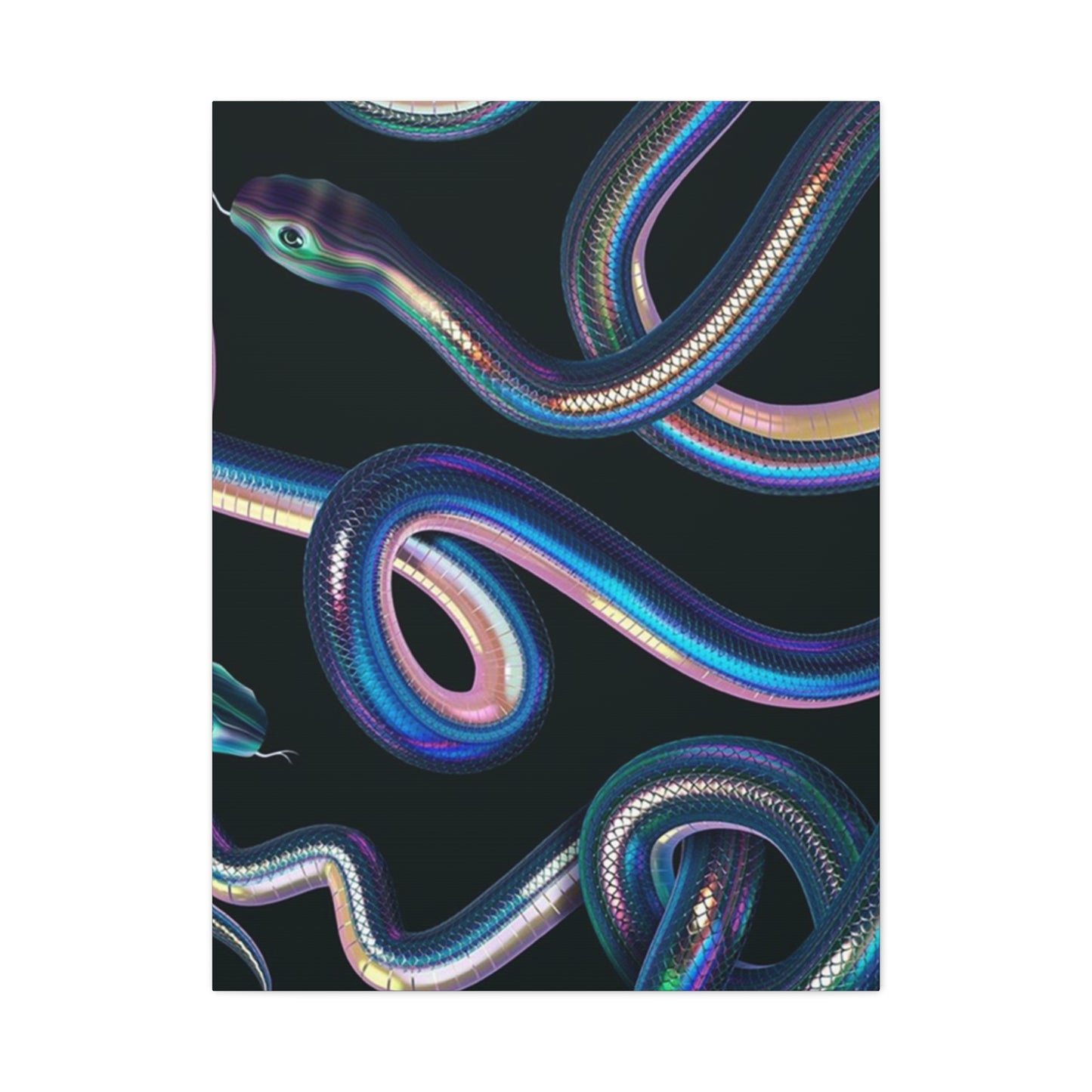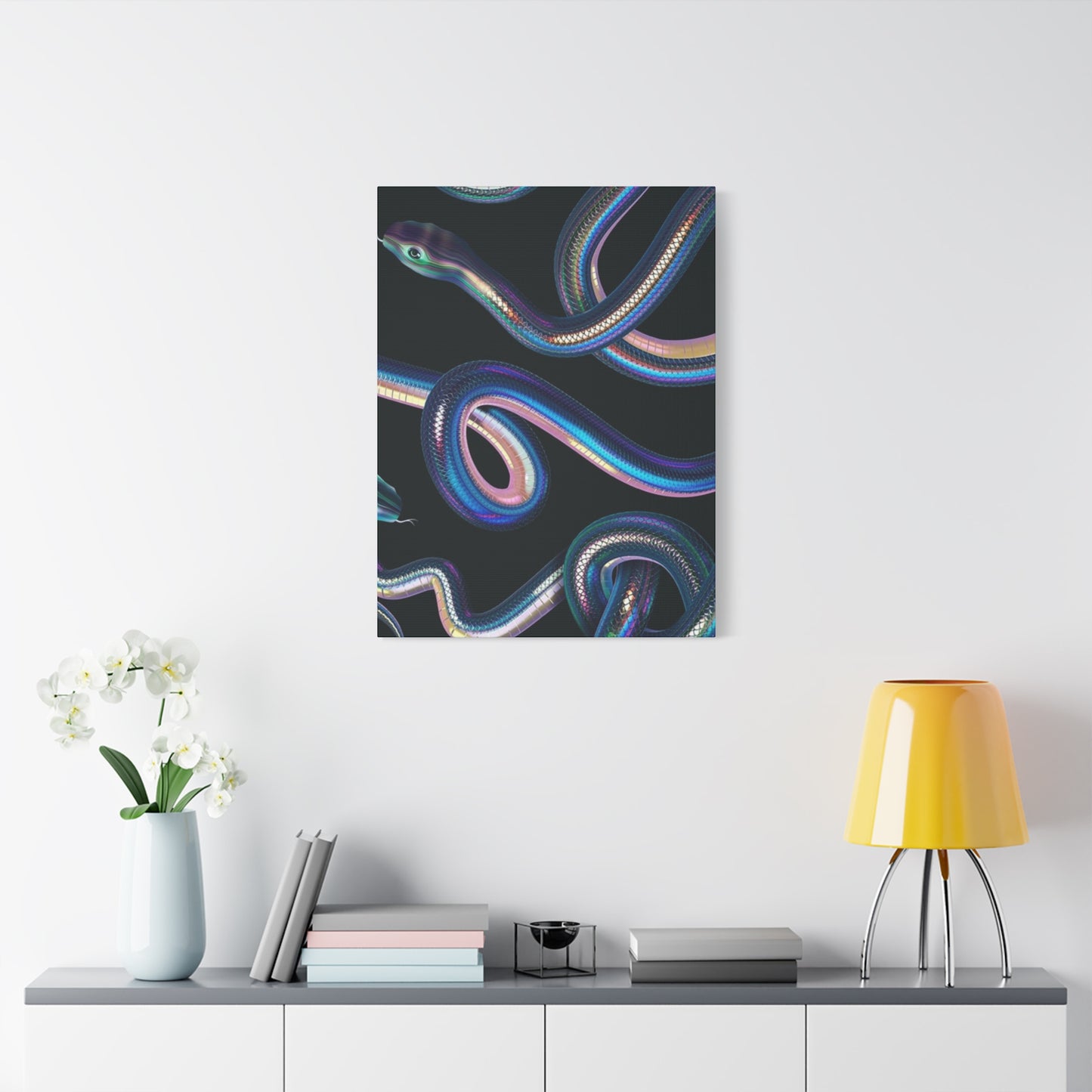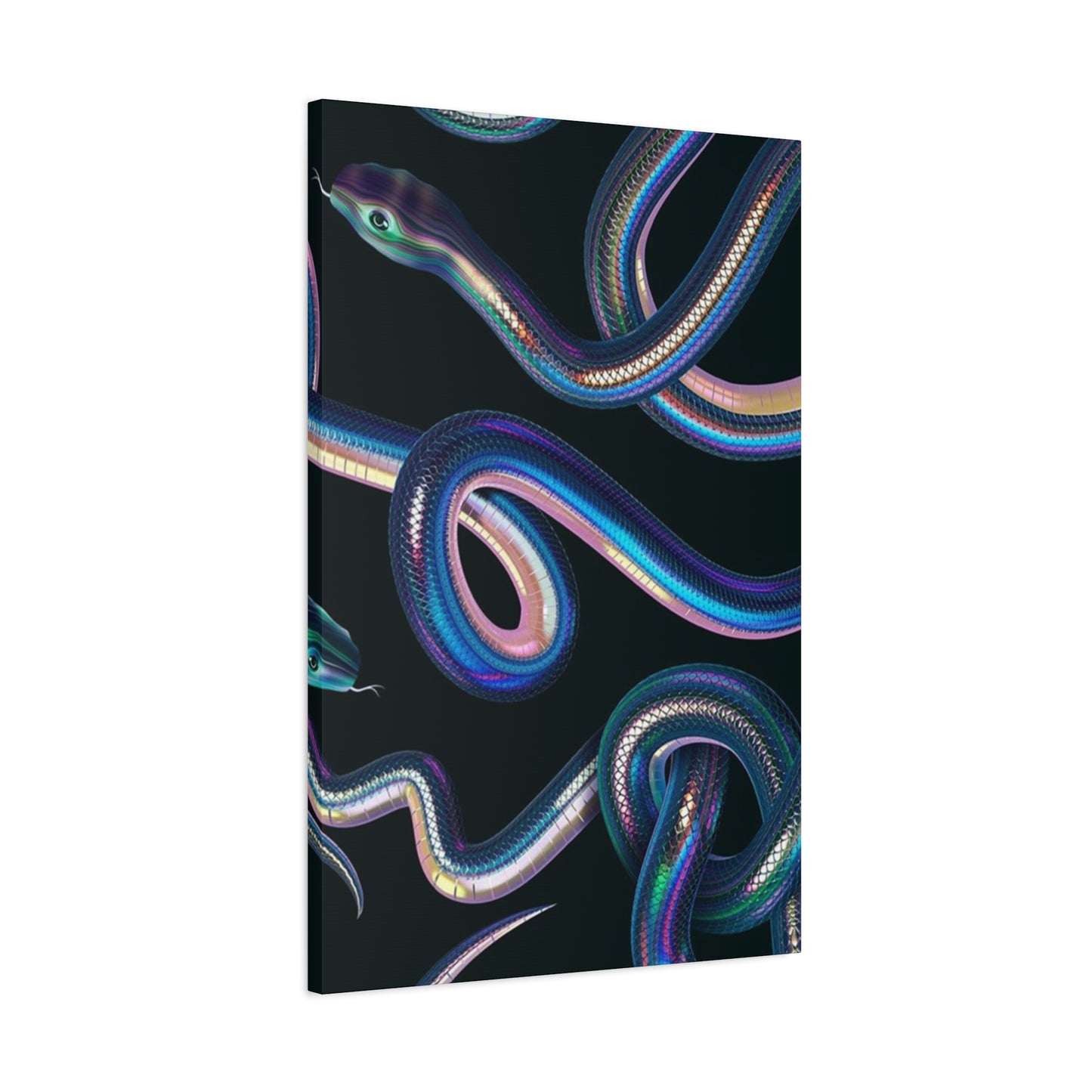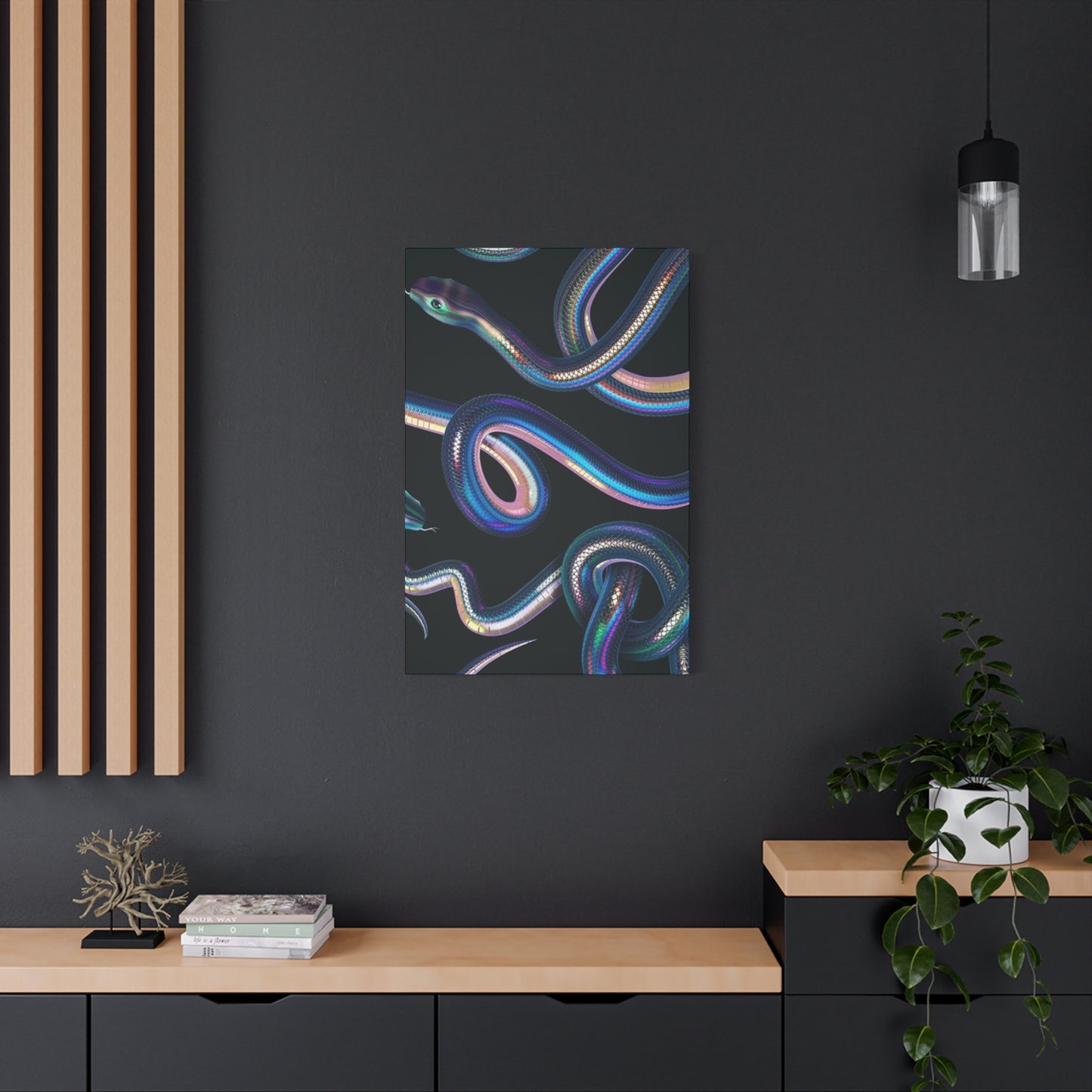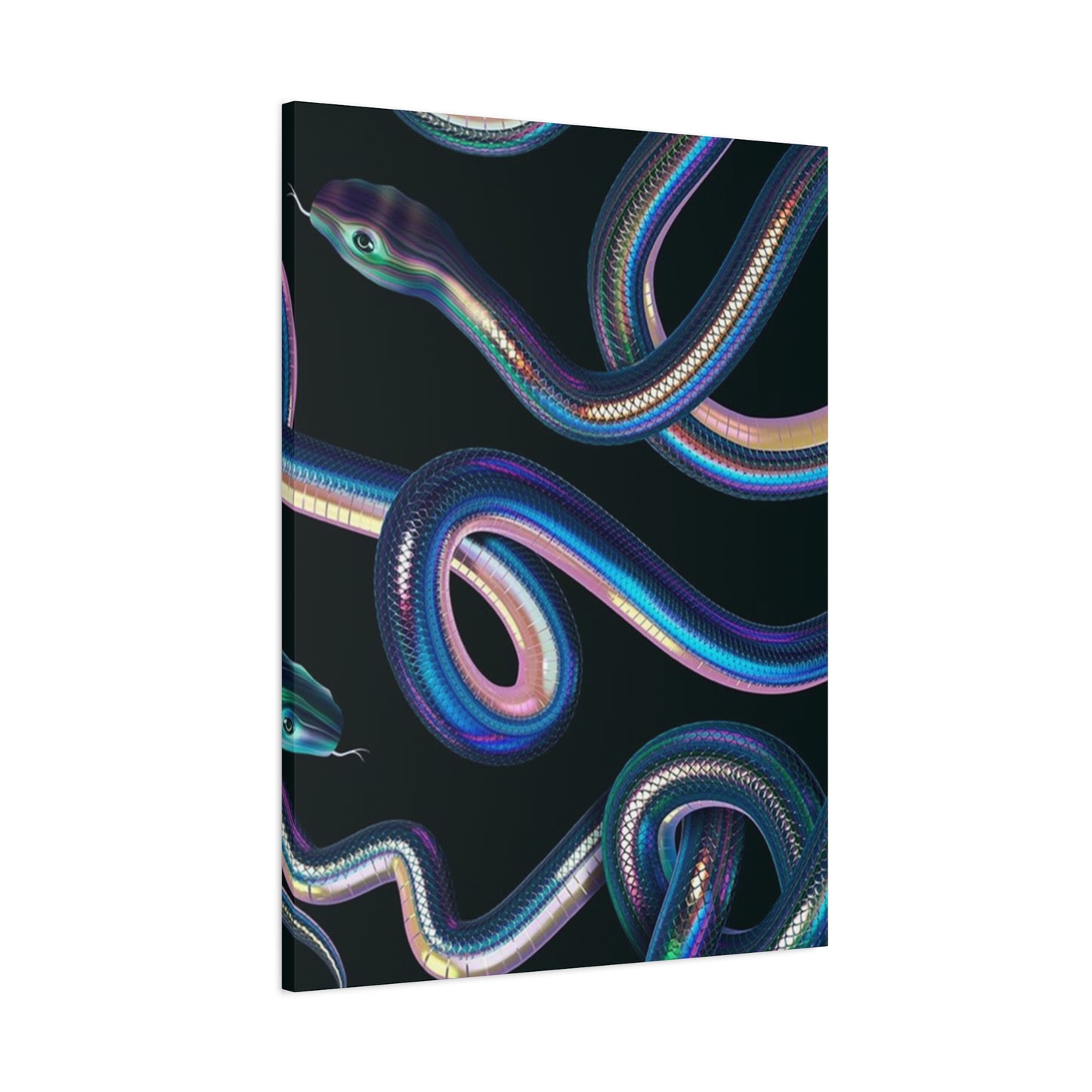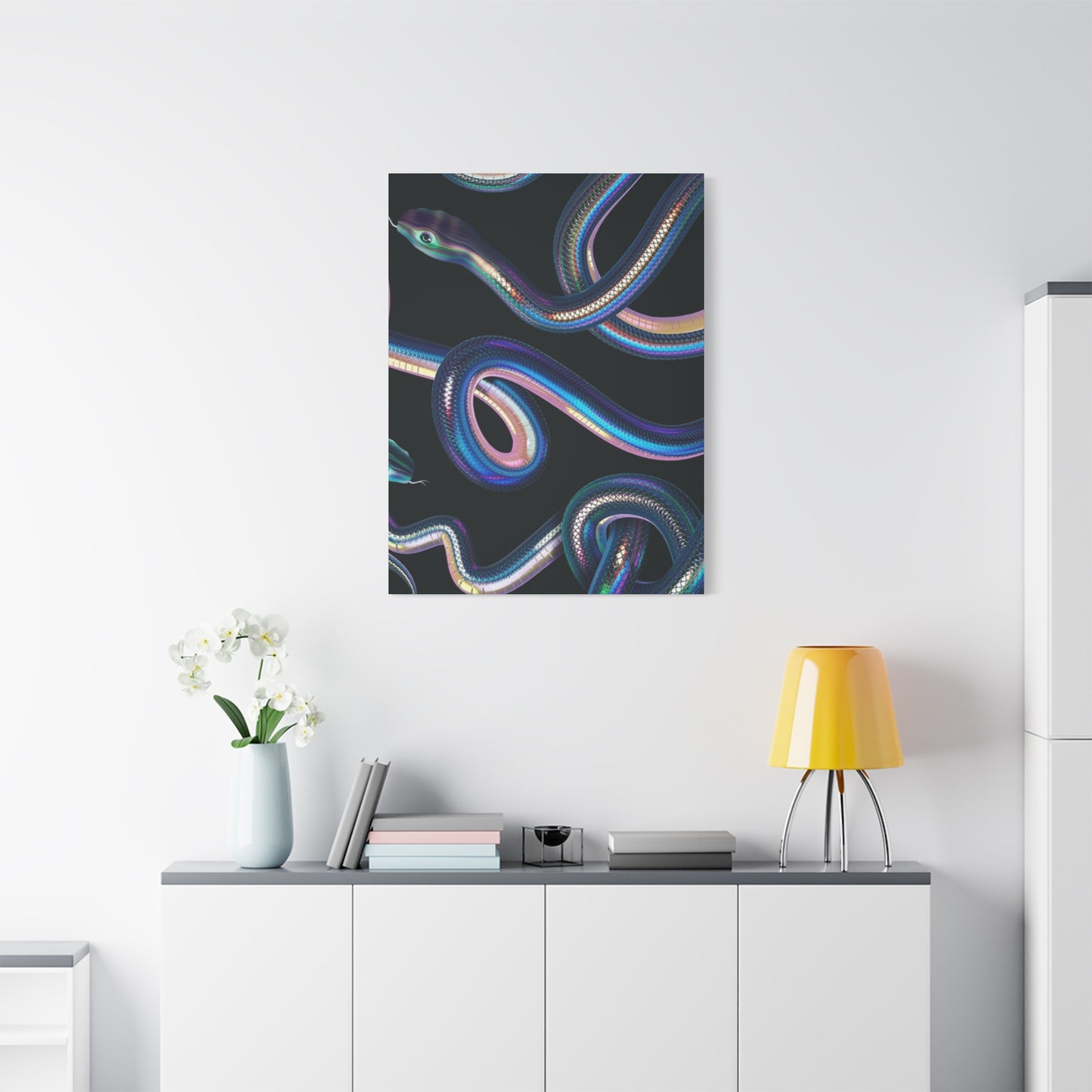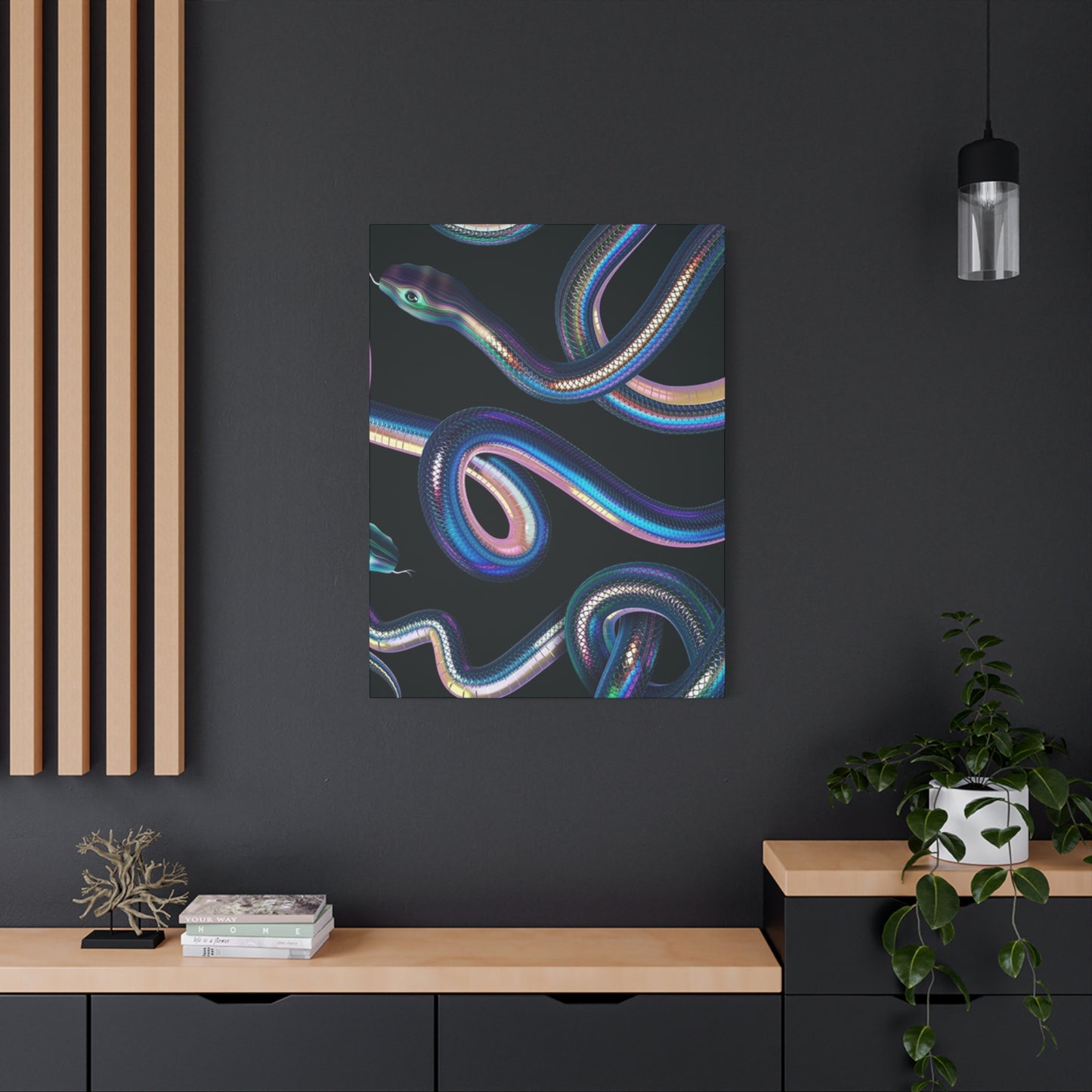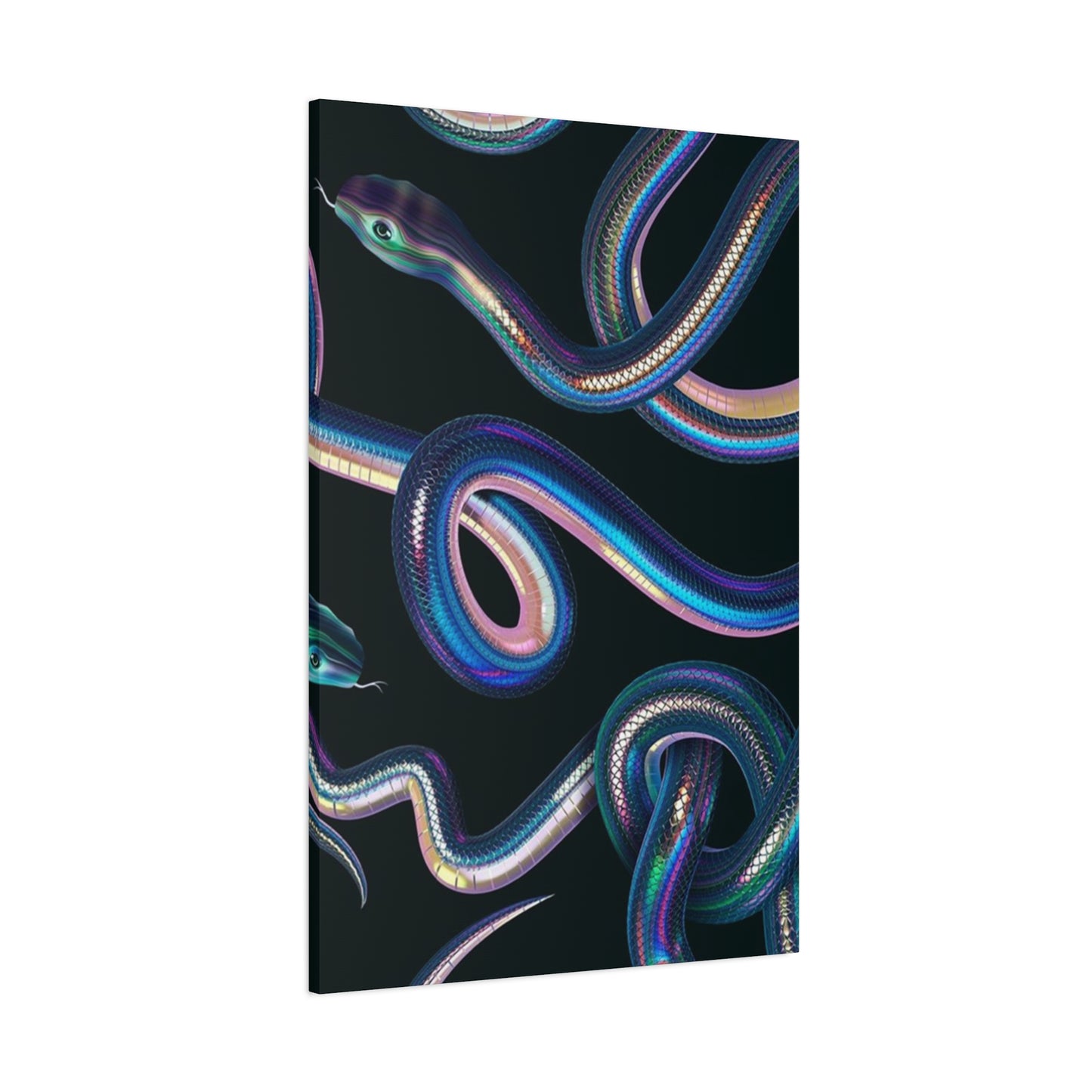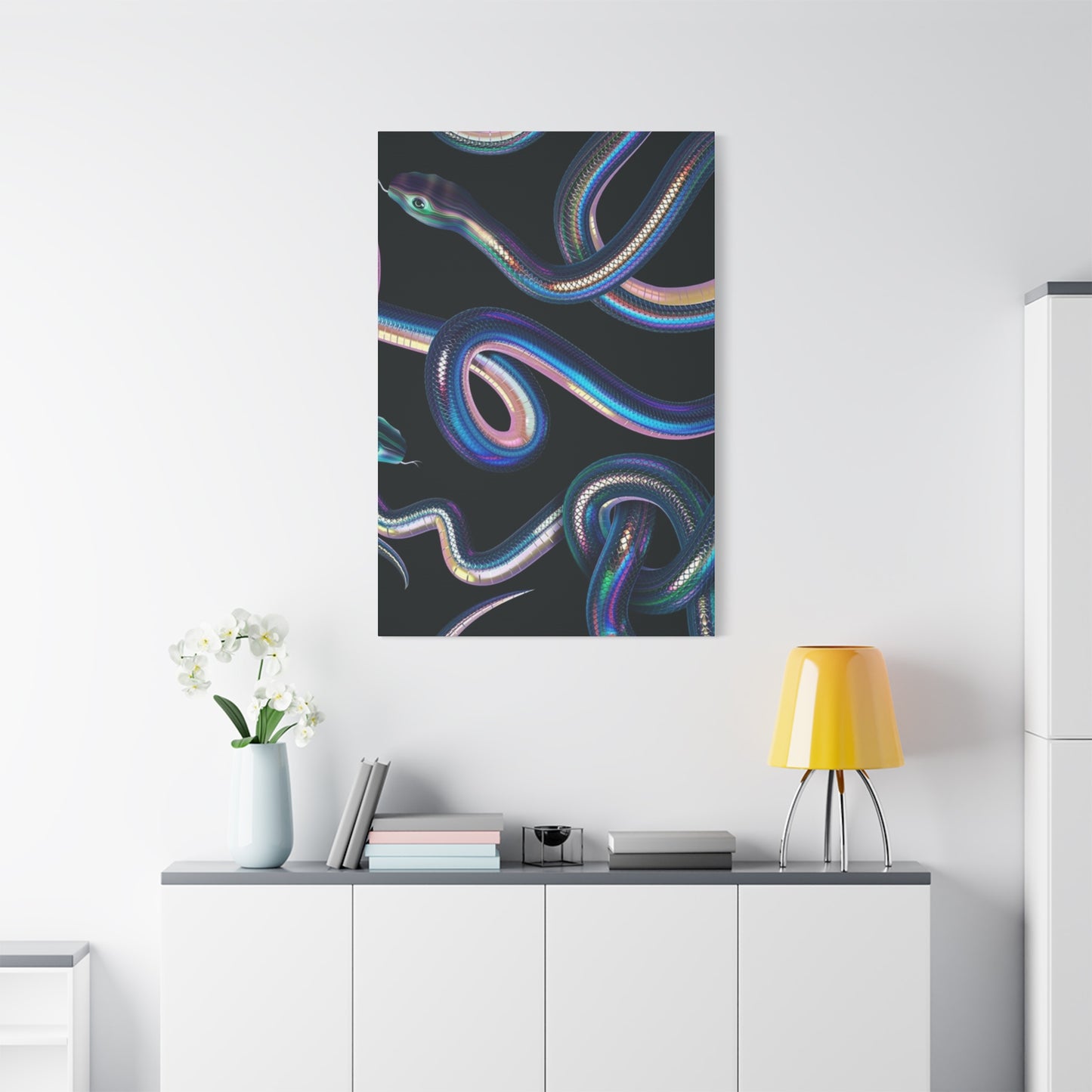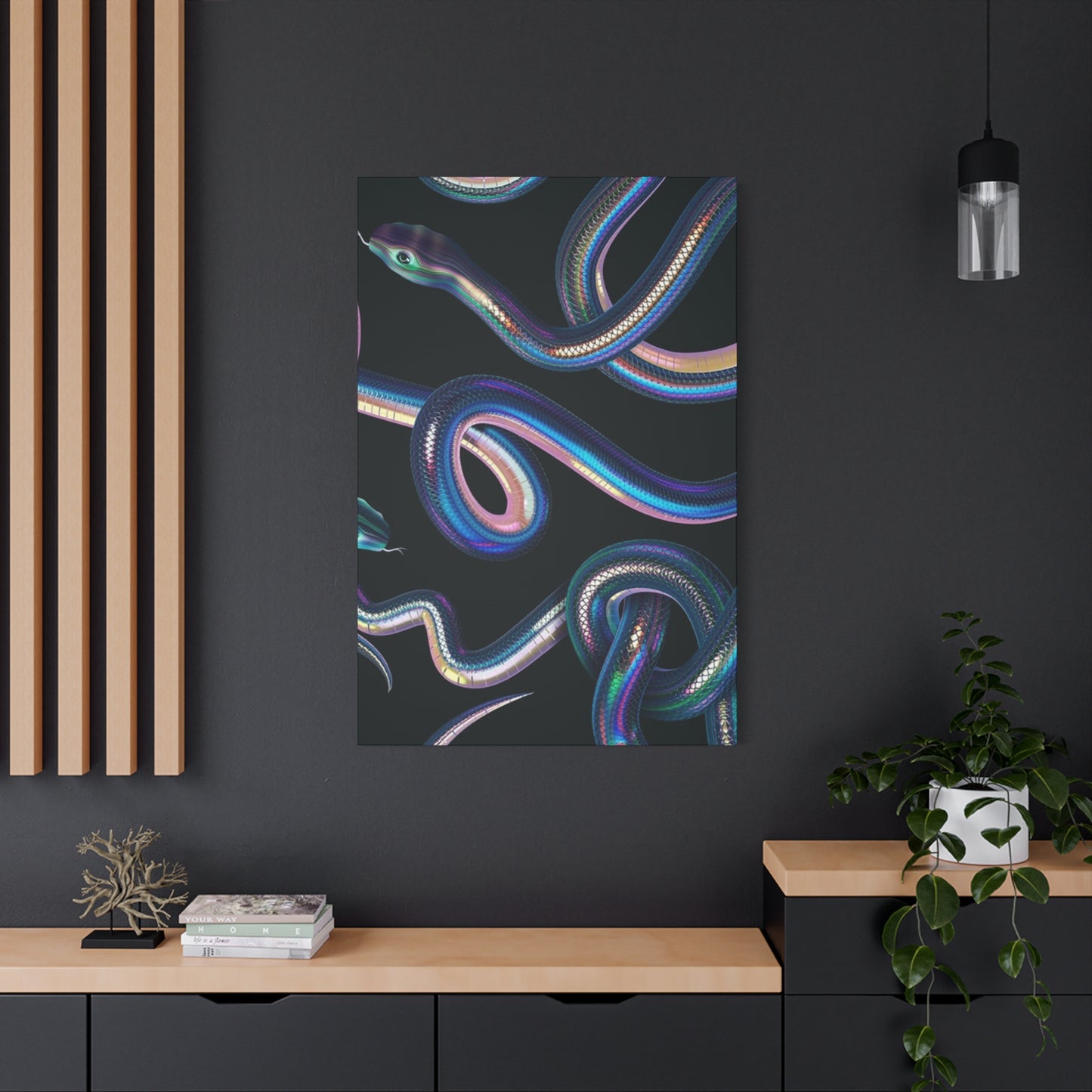The Ultimate Guide to Snake on Black Canvas Wall Art: Transforming Your Space with Serpentine Elegance
The world of interior design continuously evolves, bringing forth innovative ways to express personal style and create captivating living spaces. Among the most striking and transformative decorative elements that have captured the attention of design enthusiasts and homeowners alike is serpent-themed artwork displayed against dark backgrounds. This distinctive artistic choice combines natural beauty with bold aesthetic statements, creating focal points that command attention while adding depth and character to any room. The popularity of reptilian imagery in home decor has surged dramatically in recent years, reflecting a broader cultural appreciation for nature's most misunderstood creatures and their inherent visual appeal.
When discussing decorative elements featuring serpents against dark backgrounds, we're exploring a rich intersection of symbolism, artistry, and interior design principles. These pieces serve multiple purposes beyond mere decoration, they act as conversation starters, reflect personal interests, and demonstrate a sophisticated understanding of color theory and visual impact. The contrast between the intricate details of reptilian subjects and the deep, absorbing quality of dark backgrounds creates a visual dynamic that few other decorative choices can match.
The appeal of these artistic pieces extends across various design aesthetics, from modern minimalist spaces to bohemian sanctuaries, from industrial lofts to traditional homes seeking contemporary accents. This versatility stems from the fundamental visual principles at play: contrast, detail, and the timeless fascination humans have with these elegant creatures. Whether you're drawn to the symbolic significance of serpents in various cultures, their undeniable aesthetic appeal, or simply their ability to transform a blank wall into a statement-making feature, understanding the nuances of selecting and displaying these artworks can elevate your interior design to new heights.
Design Styles and Aesthetic Variations in Serpent-Themed Artwork
The world of serpentine artwork against dark backgrounds encompasses an impressive range of stylistic approaches, each offering unique aesthetic qualities suited to different design preferences and interior styles. Realistic representations prioritize anatomical accuracy, capturing the precise details of scales, coloration, and posture. These pieces appeal to nature enthusiasts and those who appreciate scientific illustration, bringing the beauty of actual reptilian subjects into the home environment with stunning fidelity.
Photorealistic artwork takes this approach even further, creating images so detailed they're nearly indistinguishable from photographs. These pieces showcase the artist's technical mastery while celebrating the inherent beauty of serpentine subjects. The interplay of light on scales, the subtle color gradations, and the intensity of the creature's gaze become focal points that reward close examination. Against black backgrounds, photorealistic renderings achieve a dramatic presence that commands attention in any space.
Abstract interpretations offer a completely different approach, using serpentine forms as inspiration rather than subjects for faithful reproduction. These pieces might feature flowing, sinuous lines that suggest serpentine movement without explicit representation. Color becomes a primary tool for expression, with artists employing bold palettes to create emotional impact. Abstract serpent imagery works particularly well in modern and contemporary spaces where suggestion and interpretation take precedence over literal representation.
Geometric and minimalist approaches distill serpentine forms to their essential elements, using clean lines and simplified shapes to evoke the essence of these creatures. This style appeals to those who appreciate understated elegance and modern design principles. A single curved line against a black background can suggest serpentine movement with remarkable economy, creating sophisticated artwork that complements minimalist interiors without overwhelming them.
Illustrative and decorative styles bring elements of graphic design and pattern-making to serpentine subjects. These pieces often incorporate additional design elements like geometric patterns, floral motifs, or cultural symbols, creating rich, layered compositions. The decorative approach can range from art nouveau-inspired flowing lines to bold, contemporary graphic styles. These works function as statement pieces that reflect specific aesthetic sensibilities while maintaining the powerful visual impact of serpentine imagery against dark backgrounds.
Mixed media and textured approaches add physical dimension to serpentine artwork, incorporating materials like metallic leaf, raised impasto techniques, or embedded objects. These pieces change dramatically with lighting conditions, revealing new details as viewers move around them. The textural quality adds tactile interest that flat prints cannot match, creating artwork that engages multiple senses and adds genuine depth to walls.
Color Theory and Visual Impact in Dark-Background Artwork
The relationship between color choices in serpentine subjects and their dark backgrounds follows fundamental principles of color theory while creating unique visual dynamics. Understanding these relationships helps in selecting pieces that will achieve desired effects within specific spaces. The high contrast between light or bright colors and black backgrounds creates maximum visual impact, drawing the eye immediately to the artwork and making it a natural focal point within a room.
Complementary color schemes, where colors opposite each other on the color wheel are paired, create vibrant, energetic compositions. A serpent rendered in warm oranges and golds against a cool black background creates visual tension that energizes a space. This approach works particularly well in rooms where you want to stimulate conversation and activity, such as living rooms or creative workspaces. The complementary relationship ensures the colors enhance each other's intensity, creating artwork that remains visually interesting over time.
Analogous color schemes, using colors adjacent on the color wheel, create more harmonious, calming compositions. A serpent depicted in various shades of blue and green against black produces a cohesive, sophisticated appearance. This approach suits spaces intended for relaxation or contemplation, such as bedrooms or meditation areas. The subtle variations in hue create visual interest without the energizing tension of complementary schemes.
Monochromatic approaches, using various shades and tints of a single color, create elegant, refined artwork. A serpent rendered entirely in shades of gray against a black background becomes an exercise in tonal variation and texture. This approach appeals to those who appreciate subtlety and sophistication, working beautifully in minimalist or modern interiors where restraint and refinement are design priorities.
Metallic accents add another dimension to color considerations in serpentine artwork. Gold, silver, copper, and bronze elements catch and reflect light, creating dynamic visual experiences that change throughout the day. These metallic touches can represent scales, highlights, or decorative elements, adding luxury and visual interest. The reflective quality of metallics against absorbing black backgrounds creates a compelling contrast that adds depth and sophistication to the artwork.
The saturation level of colors significantly impacts the mood and intensity of artwork. Highly saturated, vivid colors create bold, contemporary statements that work well in modern spaces with clean lines and minimal decoration. Desaturated or muted colors create more subtle, contemplative pieces suitable for traditional or transitional interiors. Understanding the relationship between color saturation and design style helps in selecting artwork that complements rather than clashes with existing decor.
Sizing Considerations and Spatial Planning for Maximum Impact
Selecting the appropriate size for serpentine artwork involves careful consideration of wall dimensions, viewing distances, and the desired visual impact within a space. Oversized pieces, those exceeding sixty inches in any dimension, create dramatic focal points that anchor entire rooms. These large-scale works suit spacious areas with high ceilings and ample viewing distances, such as living rooms, dining areas, or large hallways. The serpentine subject, when rendered at this scale against a black background, achieves a presence that can transform the character of an entire space.
Medium-sized pieces, typically ranging from thirty to sixty inches, offer versatility for various applications. These dimensions work well above furniture pieces like sofas or beds, in office spaces, or as standalone features on accent walls. The scale remains substantial enough to make a statement while maintaining proportions appropriate for standard residential rooms. Medium-sized serpentine artwork allows viewers to appreciate intricate details from comfortable conversational distances while still creating visual impact from across rooms.
Small-scale pieces, under thirty inches, work beautifully in intimate spaces, gallery wall arrangements, or as complementary elements within larger design schemes. These sizes suit bedrooms, bathrooms, home offices, or entryways where wall space is limited. Multiple small serpentine pieces can be arranged in patterns or groupings, creating visual narratives or thematic collections. The dark backgrounds help these smaller pieces maintain presence despite their modest dimensions, preventing them from disappearing against walls.
The relationship between artwork size and wall dimensions follows general design principles suggesting art should occupy between two-thirds to three-quarters of available wall width above furniture. However, serpentine imagery against black backgrounds often succeeds even when defying these conventional guidelines. The high contrast and visual weight of these pieces allow them to hold their own even when slightly undersized by traditional standards, while oversized pieces create intentionally dramatic effects that can serve specific design objectives.
Vertical versus horizontal orientation significantly impacts how serpentine artwork functions within a space. Vertical pieces emphasize height, making rooms feel taller and more spacious. This orientation naturally suits serpentine subjects in striking or climbing poses. Horizontal orientations create a sense of width and stability, working well for serpents depicted in coiled or extended positions. The orientation choice should consider both the natural posture of the serpent depicted and the proportions of the wall space being filled.
Multi-panel arrangements, where single images are divided across multiple canvas pieces, offer contemporary alternatives to single-panel artwork. These configurations create visual interest through negative space between panels while allowing for larger overall dimensions. The separation between panels adds movement and dynamism to the composition, particularly effective for serpentine subjects whose natural sinuous forms complement segmented presentations.
Material Considerations and Print Quality for Long-Lasting Visual Appeal
The physical materials used in creating serpentine artwork significantly impact both immediate visual appeal and long-term durability. Traditional stretched canvas remains the most popular choice for reasons both practical and aesthetic. Canvas provides a classic, gallery-quality appearance with subtle texture that adds depth to printed images. The wrapped edges of stretched canvas eliminate the need for framing, creating clean, contemporary presentations particularly effective with dark-background artwork.
The weight and weave of canvas material affects print quality and longevity. Premium canvases of twelve ounces or heavier provide stable surfaces that resist sagging and warping over time. Tighter weaves yield smoother surfaces for reproducing fine details like individual scales or subtle color gradations. Polyester-cotton blends offer advantages over pure cotton canvas, including better color retention, increased resistance to moisture and environmental factors, and enhanced durability under various conditions.
Acrylic and metal print substrates offer modern alternatives to traditional canvas, each bringing unique visual qualities to serpentine artwork. Acrylic prints sandwich images between clear acrylic layers, creating depth and vibrancy that make colors appear to glow. The glossy surface of acrylic enhances the jewel-like quality of serpent scales against black backgrounds, creating stunning visual impact. Metal prints infuse dyes directly into specially coated aluminum sheets, producing incredibly sharp, durable images with unique luminous quality. The metallic substrate adds subtle shimmer that complements reptilian subjects beautifully.
Paper prints, while less common for statement artwork, serve specific purposes when properly executed. Museum-quality fine art papers provide exceptional detail reproduction suitable for illustrative or photographic serpentine imagery. When matted and framed behind glass, paper prints achieve formal, gallery-like presentations appropriate for traditional interiors. However, the additional framing requirements and fragility of paper make it less practical than canvas for most residential applications.
Print technology significantly impacts image quality and longevity. Giclée printing, using archival pigment inks and high-resolution processes, produces museum-quality prints with exceptional color accuracy and fade resistance. These prints maintain their visual integrity for decades when properly cared for, making them worthy investments for serious art collectors. UV-resistant coatings and inks extend the lifespan of prints displayed in naturally lit spaces, protecting against the fading and color shifting that can occur with prolonged sun exposure.
The finishing treatment applied to artwork affects both appearance and durability. Protective coatings shield prints from moisture, dust, and minor abrasions while enhancing color vibrancy. Matte finishes minimize glare and reflection, ideal for brightly lit spaces or positions opposite windows. Glossy finishes intensify colors and create depth, particularly effective for serpentine subjects where you want to emphasize scale patterns and textures. Satin finishes offer compromise between these extremes, providing subtle sheen without excessive reflection.
Placement Strategies for Different Room Types and Functions
Strategic placement of serpentine artwork maximizes its visual impact while complementing room functions and existing design elements. Living rooms, as primary gathering spaces, offer prime opportunities for statement-making artwork. Positioning large serpentine pieces above sofas creates immediate focal points that anchor seating arrangements. The high contrast of dark-background artwork ensures visibility from multiple viewing angles, maintaining presence whether viewed from across the room or nearby seating areas.
Bedroom placements require different considerations, balancing visual interest with the room's restful purpose. Serpentine artwork above beds creates dramatic headboard alternatives, establishing strong visual anchors without physical bulk. However, some individuals find intense imagery inappropriate for sleep spaces, preferring more calming subjects. In such cases, serpentine artwork can adorn other bedroom walls, perhaps above dressers or in reading nooks, providing visual interest without dominating the restful atmosphere.
Home offices and creative workspaces benefit from artwork that stimulates thought and inspires creativity. Serpentine imagery, with its rich symbolic associations with wisdom and transformation, creates appropriate atmospheres for these functional spaces. Positioning artwork at eye level when seated ensures regular visual engagement without requiring disruption of work activities. The sophisticated appearance of serpentine subjects against black backgrounds adds professional polish to home offices used for video conferences or client meetings.
Dining rooms accommodate serpentine artwork particularly well, as the often ceremonial nature of these spaces suits the dramatic quality of dark-background pieces. Artwork positioned on focal walls creates conversation pieces that enhance dining experiences without interfering with table functions. The lighting conditions typical of dining areas, often featuring dimmable fixtures for ambiance, complement dark artwork that reveals different aspects under varying light levels.
Entryways and foyer spaces offer opportunities for immediate visual impact, establishing aesthetic tones for entire homes. Serpentine artwork in these transitional spaces creates memorable first impressions while reflecting homeowner personalities and design sensibilities. The relatively brief viewing times in entryways suit bold, high-impact imagery that communicates effectively at a glance rather than requiring extended contemplation.
Bathroom and powder room placements present unique opportunities for unexpected artistic statements. These often overlooked spaces can accommodate sophisticated serpentine artwork that surprises and delights visitors. The typically smaller dimensions of these rooms suit smaller-scale pieces or intimate groupings. However, consideration of humidity and moisture levels becomes crucial, requiring appropriate materials and protective coatings to prevent damage.
Stairways and hallways, sometimes dismissed as purely functional spaces, transform into gallery-like showcases when thoughtfully curated. Serpentine artwork arranged in ascending or descending sequences creates visual narratives that accompany movement through spaces. The linear nature of these areas suits both single large pieces that command long sight lines and collections of related pieces that reward progressive viewing.
Lighting Techniques That Enhance Dark-Background Artwork
Proper illumination dramatically affects how serpentine artwork against black backgrounds appears and functions within spaces. The absorbing quality of dark backgrounds means these pieces require more light to achieve full visual impact compared to lighter artworks. Understanding various lighting approaches allows optimization of artwork presentation while creating desired atmospheric effects.
Picture lights, dedicated fixtures mounted directly above or below artwork, provide focused illumination that highlights details while creating dramatic shadows. LED picture lights offer advantages including minimal heat production, energy efficiency, and precise beam control. Adjustable models allow customization of light direction and intensity, accommodating different artwork sizes and mounting heights. The direct illumination from picture lights makes serpentine scales and color variations clearly visible even in dimly lit rooms.
Track lighting systems offer flexibility for illuminating multiple artworks or adjusting light positions as decor evolves. Individual track heads can be aimed precisely at serpentine pieces, creating gallery-style presentations in residential settings. The ability to adjust light angles throughout the day optimizes artwork appearance under changing natural light conditions. Dimmer controls allow mood customization, from bright illumination for detailed viewing to subtle accent lighting for atmospheric effects.
Recessed spotlights integrate lighting solutions seamlessly into ceilings, providing clean, unobtrusive illumination. These fixtures work particularly well for permanent artwork installations where picture lights might detract from minimalist aesthetics. Narrow beam angles create focused pools of light that draw attention to artwork while allowing surrounding areas to recede, emphasizing the focal point nature of serpentine pieces.
Ambient lighting, while not directly illuminating artwork, significantly affects how dark-background pieces appear within spaces. Rooms with generous natural light during daytime hours showcase serpentine artwork differently than artificially lit evening conditions. Consideration of primary usage times informs lighting design decisions, ensuring artwork appears as intended during peak viewing periods.
The color temperature of light sources dramatically impacts color perception in artwork. Warm light sources, typically between 2700K and 3000K, create cozy, inviting atmospheres but can shift color perception toward yellow and orange tones. Cool light sources, around 4000K to 5000K, more accurately represent colors as artists intended them but may feel clinical in residential settings. Neutral white light at approximately 3500K often provides optimal balance for artwork viewing, accurately representing colors while maintaining comfortable residential ambiance.
Directional lighting creates depth and dimension in serpentine artwork through strategic shadow creation. Light positioned at angles rather than directly perpendicular to artwork reveals texture in canvas surfaces and emphasizes the dimensional quality of serpent scales. This approach particularly enhances mixed media pieces with physical texture, creating constantly changing appearances as viewers move through spaces and lighting angles shift relative to viewing positions.
Creating Cohesive Design Schemes Around Serpentine Artwork
Integrating serpentine artwork against black backgrounds into broader design schemes requires consideration of multiple elements to achieve cohesive, intentional aesthetics. The bold nature of these pieces positions them as natural focal points around which other design decisions can orbit. Color palette extraction from artwork provides one approach to ensuring cohesion, selecting furnishings, textiles, and accessories in colors appearing within the serpentine piece itself.
For artwork featuring emerald green serpents, incorporating green accents throughout the space through throw pillows, plants, or decorative objects creates visual connections that unify the design. The black background of the artwork can be echoed in smaller doses through picture frames, light fixtures, or accent furniture, reinforcing the color relationship without overwhelming the space with darkness. This extraction approach ensures the artwork feels integrated rather than arbitrarily selected.
Complementary color schemes offer alternative approaches, using colors opposite those featured in artwork to create vibrant, energetic spaces. If serpentine artwork features warm tones like orange or red, incorporating cool blues or greens in surrounding decor creates dynamic tension that energizes spaces. This approach requires careful balance to avoid color chaos, typically designating one color as dominant while using its complement as accent.
Textural variety adds depth and interest to spaces featuring serpentine artwork, preventing flat, one-dimensional appearances. The smooth, often glossy quality of serpent scales depicted in artwork can be contrasted with rough, natural textures in other elements. Woven textiles, raw wood furniture, or stone accent pieces create tactile variety that makes spaces feel more dynamic and engaging. Alternatively, emphasizing smooth, sleek surfaces throughout a space creates cohesive modern aesthetics where serpentine artwork feels perfectly at home.
Pattern mixing requires careful consideration when working with serpentine imagery, which itself constitutes a form of pattern through scale arrangements. Additional patterns in textiles or wallpaper should either be scale-compatible with the artwork or sufficiently different to avoid visual conflict. Geometric patterns often complement organic serpentine forms through contrast, while other natural patterns like florals or botanicals can create thematic coherence around nature-inspired design.
Metallic accents appearing in serpentine artwork inform metal finish choices throughout spaces. If artwork features gold highlights on serpent scales, brass or gold-toned light fixtures, hardware, and accessories create cohesive metallic themes. Silver or white metals in artwork suggest chrome, stainless steel, or silver accessories. Mixing metal finishes can work but requires careful attention to maintaining visual balance and intentional eclecticism rather than accidental mismatch.
Furniture style selection impacts how serpentine artwork reads within spaces. Modern, streamlined furniture with clean lines complements the sophisticated appearance of serpents against black backgrounds, creating cohesive contemporary aesthetics. Traditional furniture styles can work but require careful selection to avoid jarring contrasts between ornate classical pieces and bold modern artwork. Transitional styles that blend traditional and contemporary elements often provide ideal middle ground, allowing serpentine artwork to coexist comfortably with various furniture approaches.
Scale relationships between artwork and furniture prevent design disconnection. Substantial artwork requires furniture with visual weight sufficient to anchor it, preventing the appearance of artwork floating disconnected from room arrangements. Conversely, delicate, minimal furniture pairs well with more restrained artwork, maintaining consistent scale relationships throughout spaces. The high visual weight of dark-background serpentine pieces means they require substantial furniture partnerships to achieve balance.
Framing and Mounting Options for Professional Presentation
While many serpentine pieces on dark backgrounds are designed for frameless presentation, particularly stretched canvas works, framing options offer both protective and aesthetic benefits. Custom framing transforms artwork into true gallery pieces, adding layers of visual interest and protecting edges from damage. Frame selection significantly impacts overall appearance, with different styles creating dramatically different effects.
Minimalist frames in simple metals or narrow wood profiles maintain focus on artwork rather than frame itself. Black frames create seamless continuity with dark artwork backgrounds, making the entire piece feel cohesive and integrated. This approach works particularly well in modern or contemporary spaces where clean lines and simplicity reign. Narrow aluminum or steel frames add industrial edge while providing protection without visual bulk.
Statement frames make deliberate design choices, adding significant visual presence that transforms artwork presentations. Ornate frames in gold or silver leaf create traditional, formal appearances suitable for classical interiors. However, the contrast between ornate frames and contemporary serpentine subjects can create interesting tensions that work in eclectic or maximalist design schemes. Wide, architectural frames in rich woods add substance and gravitas to serpentine pieces, suitable for traditional or rustic settings.
Floating frames create the illusion of artwork suspended within frame boundaries, adding dimension and contemporary style. This approach works beautifully with serpentine imagery, as the visible gap between artwork and frame suggests the serpent might slither free. The three-dimensional quality of floating frames adds physical depth that complements the visual depth inherent in dark-background artwork.
Frameless mounting systems offer clean, contemporary alternatives to traditional framing while providing secure installations. French cleats create flush wall mounting with easy removal for cleaning or repositioning. These systems distribute weight evenly, supporting even large, heavy artworks safely. The gap between wall and artwork created by cleats adds subtle shadows that give pieces visual separation from walls, enhancing their three-dimensional quality.
Wire hanging systems, while functional, often detract from streamlined presentations serpentine artwork deserves. D-rings positioned on canvas backs or frame backs create more refined hanging solutions that maintain clean sight lines. For particularly heavy or valuable pieces, professional installation using wall anchors appropriate for wall types ensures secure, lasting mounting that protects both artwork and walls from damage.
Gallery walls incorporating serpentine artwork require careful planning to achieve cohesive arrangements. The high visual weight of dark-background pieces means they function best as anchor points within gallery arrangements rather than one among many equal pieces. Surrounding serpentine artwork with complementary pieces in lighter tones or smaller scales creates hierarchy that prevents visual chaos. Symmetrical gallery arrangements create formal, balanced appearances, while asymmetrical layouts offer dynamic, contemporary alternatives.
Template systems simplify gallery wall planning, allowing arrangement testing before committing to wall holes. Paper templates matching frame sizes can be taped to walls and rearranged until ideal configurations emerge. Photographing potential arrangements provides perspective on how configurations will appear from various viewing distances, essential for achieving gallery walls that function successfully across entire rooms rather than only at specific positions.
Trends and Contemporary Movements in Serpentine Art
The contemporary art world continually evolves, with serpentine imagery experiencing renewed interest across multiple movements and styles. Understanding current trends helps identify works that feel fresh and contemporary rather than dated or derivative. The rise of digital art has democratized serpentine imagery creation, allowing artists worldwide to produce and distribute work reaching global audiences without traditional gallery systems.
Hyperrealism has gained tremendous popularity, with artists creating serpentine imagery so detailed it rivals or exceeds photography. These works showcase technical mastery while celebrating subjects in unprecedented detail. Against black backgrounds, hyperrealistic serpents achieve almost supernatural presence, appearing ready to emerge from the surface at any moment.
Surrealist approaches merge serpentine forms with unexpected elements, creating dreamlike compositions that challenge perception and invite interpretation. These works might feature serpents composed of unusual materials, inhabiting impossible landscapes, or interacting with symbolic objects. The black background common to these pieces enhances their otherworldly quality, separating them from mundane reality into purely imaginative realms. Collectors drawn to thought-provoking artwork that sparks conversation find surrealist serpentine pieces particularly appealing.
Environmental and conservation themes have entered serpentine artwork, with artists using their work to raise awareness about threatened reptile species and habitat loss. These pieces often juxtapose the beauty of serpents with subtle references to human impact, creating artwork that's simultaneously beautiful and meaningful. The educational aspect adds depth beyond decoration, allowing homeowners to support conservation messages through their design choices.
Cultural fusion approaches blend serpentine imagery with elements from multiple artistic traditions, creating hybrid works that reflect increasingly global artistic perspectives. An artist might combine traditional Japanese ink painting techniques with contemporary color palettes, or merge indigenous Australian dot painting methods with photorealistic serpent depictions. These cross-cultural works celebrate artistic diversity while creating fresh interpretations of timeless subjects.
Minimalist trends in contemporary art have influenced serpentine imagery, with some artists reducing subjects to essential lines and shapes. A single elegant curve against black might suggest an entire serpent through economy of form. These pieces appeal to collectors who appreciate restraint and subtlety, allowing the artwork to integrate seamlessly into minimalist interiors without overwhelming carefully curated spaces.
Technological integration represents an emerging frontier in serpentine artwork, with some pieces incorporating LED lighting, projection mapping, or even animated elements. While these high-tech approaches may not suit traditional canvas presentations, they represent exciting developments for collectors interested in cutting-edge artistic expressions. The serpent's sinuous form lends itself beautifully to animated treatments where movement becomes part of the artistic statement.
Combining Multiple Pieces for Gallery Walls and Collections
Creating cohesive collections of serpentine artwork offers opportunities for more complex storytelling and visual impact than single pieces can achieve. Thematic collections might focus on different serpent species, showcasing the diversity within reptilian family through varied colorations, patterns, and body structures. Arranging these pieces together creates educational displays that celebrate biodiversity while maintaining strong aesthetic cohesion through shared compositional approaches and background treatments.
Sequential storytelling through multiple pieces allows narrative development across wall space. A series might depict a serpent's life cycle from hatchling to mature adult, or show seasonal color variations as serpents respond to environmental changes. These narrative collections transform walls into visual stories that reward repeated viewing as observers discover new connections and details within the series.
Stylistic variation collections combine different artistic approaches to the same subject matter, perhaps including realistic, abstract, and geometric interpretations of serpentine forms. This approach celebrates artistic diversity while maintaining subject continuity. The black backgrounds common to serpentine pieces help unify disparate styles that might otherwise feel disconnected, allowing bold experimentation with form and technique while maintaining overall coherence.
Size gradation creates visual rhythm in multi-piece installations, with sizes progressing from large to small or arranged in symmetrical patterns around central focal pieces. This approach adds architectural quality to arrangements, with the artwork functioning almost as three-dimensional sculptural elements rather than flat wall decorations. The progression guides viewer attention through intentional pathways, creating dynamic viewing experiences.
Color progression arrangements organize pieces by dominant color, creating gradual transitions across wall space. Beginning with cool-toned serpent imagery and progressing through warm tones creates rainbow effects that feel organic despite careful planning. This approach works particularly well for large wall expanses where single pieces would be overwhelmed but coordinated collections create appropriate scale.
Mixed media combinations incorporate serpentine artwork alongside complementary subjects or abstract pieces, creating eclectic collections united by color, theme, or emotional tone rather than identical subject matter. This approach allows more personal expression, as collectors can integrate serpentine pieces they love with other meaningful artwork. The strong visual presence of serpents against black backgrounds often allows them to anchor these diverse collections, providing focal points around which other elements orbit.
Symmetrical arrangements create formal, balanced presentations suitable for traditional spaces or centered wall compositions. Pairs of matching or complementary serpentine pieces flanking central elements like doorways or furniture create classical symmetry that feels deliberate and considered. This approach requires careful attention to visual weight and color balance to achieve pleasing equilibrium.
Asymmetrical arrangements offer contemporary alternatives that feel dynamic and energetic. Odd numbers of pieces arranged according to visual weight rather than physical symmetry create interest while maintaining balance. The rule of thirds can guide placement, with focal pieces positioned at intersection points rather than centered. This approach feels modern and less predictable than symmetrical arrangements.
Pairing Serpentine Artwork with Complementary Decor Elements
Successful interior design requires coordinating multiple elements to create cohesive, intentional spaces. Serpentine artwork against black backgrounds functions as anchor points around which other decorative decisions revolve. Plant selections offer natural partnerships, with serpentine imagery's connection to nature making botanical elements appropriate companions. Snake plants, appropriately named, create thematic coherence while adding living elements that soften the intensity of dark artwork.
Sculptural elements in complementary forms enhance serpentine artwork through dimensional variety. Sinuous sculptural pieces echo serpentine curves in three-dimensional space, creating dialogue between two-dimensional and three-dimensional artistic expressions. Materials like bronze, carved wood, or blown glass add textural variety while maintaining formal relationships with serpentine subjects depicted in artwork.
Textile selections influence how serpentine artwork functions within overall design schemes. Smooth, luxurious fabrics like velvet or silk echo the sleek quality of serpent scales, creating cohesive sensory experiences. Alternatively, rough, natural fibers provide textural contrast that prevents spaces from feeling too refined or polished. Pattern selection in textiles requires careful consideration, with geometric patterns often complementing organic serpentine forms better than competing organic patterns.
Lighting fixtures beyond those illuminating artwork contribute to overall atmosphere supporting serpentine pieces. Contemporary fixtures with organic, flowing forms echo serpentine movement, while angular, geometric fixtures provide formal contrast. Metallic finishes in lighting should coordinate with any metallic elements within artwork itself, creating cohesive material themes throughout spaces.
Furniture arrangements that acknowledge artwork placement create intentional relationships between functional and decorative elements. Seating positioned to allow comfortable artwork viewing demonstrates thoughtful space planning. Coffee tables or side tables styled with objects that complement artwork colors or themes strengthen visual connections between furniture groupings and wall displays.
Decorative object selections offer opportunities for thematic development or intentional contrast. Collections of natural objects like crystals, geodes, or driftwood create connections to the natural world serpentine artwork represents. Books about reptiles, mythology, or natural history add intellectual dimension while creating visual interest on shelves or tables. However, overly literal thematic development risks feeling contrived, requiring balanced approaches that suggest connections without heavy-handed coordination.
Color accents throughout spaces create visual pathways that include serpentine artwork as part of larger color stories. Throw pillows, vases, or decorative objects in colors appearing within artwork create moments of connection that unify rooms. This approach works particularly effectively when accent colors appear in unexpected places, creating delightful discoveries as visitors notice subtle coordinations between disparate elements.
Cultural Sensitivity and Symbolic Respect in Serpent Imagery
Serpents hold profound significance in numerous cultural and religious traditions, requiring thoughtful consideration when selecting and displaying imagery. Understanding these associations prevents inadvertent disrespect while enriching appreciation for pieces incorporating cultural symbolism. In Hindu tradition, serpents represent divine power and protection, with snake deities like Shesha and Vasuki playing crucial cosmological roles. Artwork drawing on these traditions should be displayed respectfully, acknowledging their sacred origins.
Indigenous cultures worldwide hold complex relationships with serpents, viewing them as ancestors, teachers, or spiritual beings deserving reverence. Using serpent imagery derived from indigenous traditions without understanding or acknowledgment can constitute cultural appropriation. Collectors interested in culturally-specific serpentine artwork should research meanings and contexts, ensuring their display respects rather than trivializes sacred symbols.
Chinese culture associates serpents with wisdom and good fortune, particularly in feng shui traditions where serpent energy relates to transformation and renewal. Understanding these positive associations helps in thoughtful placement within homes, potentially positioning serpentine artwork in areas where symbolic meanings align with room purposes, such as serpents representing wisdom in home offices or libraries.
Western traditions have more ambivalent serpent relationships, with Christian symbolism often casting serpents as representations of temptation or evil alongside medical traditions celebrating serpents as healing symbols. These contradictory associations mean Western audiences may respond to serpentine imagery with complex, sometimes conflicting emotions. Awareness of these cultural layers adds depth to artwork appreciation.
Contemporary artists increasingly create serpentine works that honor traditional symbolism while speaking to modern sensibilities. These pieces might blend elements from multiple cultural traditions, creating hybrid works reflecting globalized contemporary culture. Understanding artists' intentions and cultural references enriches viewing experiences, transforming artwork from mere decoration into meaningful cultural dialogue.
Appropriation versus appreciation remains an ongoing conversation in art world discussions about cultural borrowing. Generally, appreciation involves understanding, respect, and acknowledgment of cultural sources, while appropriation takes cultural elements without understanding or credit. Supporting artists from cultures being represented or those who explicitly acknowledge and respect source traditions promotes ethical collecting practices.
Education about symbolic meanings enriches personal relationships with artwork while informing conversations with visitors. Being able to discuss cultural significance demonstrates respect and genuine interest beyond surface aesthetics. This knowledge transforms artwork into educational tools that promote cross-cultural understanding and appreciation.
Investment Potential and Art Market Considerations
While artwork should primarily be selected for aesthetic enjoyment and personal connection, understanding market dynamics provides helpful context for collectors considering serpentine pieces as potential investments. The contemporary art market has grown increasingly accessible to diverse collectors, with online platforms democratizing access to artists and artworks previously available only through traditional galleries.
Artist reputation significantly impacts investment potential, with established artists commanding higher prices and more stable market values than emerging talents. However, emerging artists present opportunities for significant appreciation if they gain recognition. Researching artist backgrounds, exhibition histories, and critical reception provides insight into likely market trajectories, though predicting future success remains inherently uncertain.
Limited edition prints offer middle-ground investment potential between mass-produced works with minimal appreciation likelihood and original pieces requiring substantial capital. Authentically limited editions with proper documentation maintain value better than unlimited prints while remaining more affordable than originals. Edition size matters, with smaller editions generally holding value better than larger runs.
Documentation and provenance affect artwork value significantly. Certificates of authenticity, artist signatures, edition numbering, and purchase receipts all contribute to establishing artwork legitimacy and value. Maintaining this documentation protects investment value, particularly important for pieces intended as financial assets rather than purely aesthetic purchases.
Market trends influence short-term values, with certain subjects, styles, or artists experiencing temporary popularity surges. Serpentine imagery's timeless appeal across cultures suggests resistance to extreme trend-based volatility, though specific artistic approaches may experience fluctuating demand. Long-term investment perspectives reduce risk associated with trend-driven market movements.
Condition preservation protects investment value, making proper care and maintenance financially prudent beyond aesthetic considerations. Damage from light exposure, moisture, or physical trauma diminishes value significantly, sometimes irreparably. Insurance for valuable pieces protects against loss from theft, damage, or disasters, with specialized art insurance offering more appropriate coverage than standard homeowner policies.
Resale considerations include commission structures for galleries or auction houses, which typically retain substantial portions of sale prices. Online platforms may offer better returns but provide less vetting and authentication assurance. Understanding these dynamics helps set realistic expectations about potential returns on art investments.
Digital Art and NFT Considerations in Serpentine Imagery
The emergence of digital art and blockchain-based authentication through non-fungible tokens has created new possibilities for serpentine artwork collection. Digital art offers advantages including perfect reproduction without degradation, easy storage and display through digital frames, and lower price points for entry-level collecting. However, digital pieces lack the physical presence and traditional artistic qualities many collectors value.
NFT technology addresses authentication and ownership challenges that previously limited digital art market development. Blockchain verification provides indisputable provenance and ownership records, creating scarcity in inherently reproducible digital medium. Serpentine artists have embraced NFT platforms, creating limited digital editions marketed to tech-savvy collectors comfortable with cryptocurrency transactions.
Display considerations for digital artwork differ dramatically from physical pieces. Digital frames ranging from affordable to premium prices allow rotation through collections with simple uploads, enabling dynamic displays impossible with physical artwork. However, the glowing quality of backlit digital displays creates different aesthetic effects than traditionally illuminated physical artwork, requiring adjustment in expectations and design integration.
Environmental concerns around NFT technology stem from energy consumption of blockchain networks, particularly proof-of-work systems. This has sparked controversy within art communities, with some artists and collectors avoiding NFTs due to environmental objections while others argue technological improvements are reducing environmental impacts. Understanding these issues helps align collecting practices with personal values.
The speculative nature of NFT markets has created volatile pricing that many observers compare to financial bubbles. While some digital serpentine artworks have sold for substantial sums, market sustainability remains questionable. Collectors interested in digital artwork should prioritize aesthetic appeal and personal connection over investment potential given market uncertainty.
Rights and reproduction in digital art require clear understanding, as ownership of NFTs doesn't necessarily transfer copyright or reproduction rights. The ability to view or save digital images online complicates scarcity that partially drives traditional art values. These unique characteristics of digital art markets require different evaluation frameworks than physical artwork markets.
Creating Themed Rooms Around Serpentine Artwork
Fully committed design schemes organized around serpentine artwork create immersive environments that make bold statements about personal style and interests. Natural history themes celebrate scientific curiosity and appreciation for biodiversity, incorporating serpentine artwork alongside other natural specimens, botanical prints, and nature-inspired decor. These rooms feel like personal museums or cabinets of curiosities, reflecting intellectual engagement with natural world.
Mythological themes draw on serpents' rich symbolic history across cultures, incorporating artwork depicting specific mythological serpents alongside related imagery and artifacts. Greek mythology rooms might feature serpentine pieces alongside classical sculptures and Mediterranean color palettes, while Norse-inspired spaces could combine serpent imagery with runic elements and Nordic design sensibilities.
Dark academia aesthetics pair naturally with serpentine imagery, creating scholarly, sophisticated environments that feel both intellectual and mysterious. Rich wood furniture, extensive book collections, vintage-inspired textiles, and moody lighting complement serpentine artwork against black backgrounds perfectly. These spaces feel timeless and cultured, appealing to those who value knowledge, tradition, and refined aesthetics.
Gothic and Victorian-inspired themes embrace serpentine imagery's darker romantic qualities, combining ornate furnishings, rich fabrics, and dramatic lighting with serpent artwork. Deep jewel tones, velvet upholstery, and antique or reproduction furniture create appropriate settings for serpentine pieces, particularly those with ornate frames or traditional artistic approaches.
Bohemian and eclectic themes allow serpentine artwork to coexist with diverse elements from various cultures and periods. These maximalist approaches layer patterns, textures, and collected objects to create personalized, expressive environments. Serpentine imagery adds edge and sophistication that prevents bohemian spaces from feeling too casual or unfocused.
Modern minimalist interpretations use serpentine artwork as rare decorative elements within otherwise spare environments. A single spectacular serpentine piece against neutral walls becomes powerful focal point, with all other elements subordinated to artwork's visual impact. This approach suits those who appreciate both bold art and minimal clutter.
Professional Interior Design Integration Services
Professional interior designers bring expertise that elevates serpentine artwork integration beyond amateur efforts. Designers understand spatial relationships, color theory, and style principles at levels that ensure cohesive results. When working with designers on projects incorporating serpentine artwork, clear communication about preferences prevents misunderstandings while allowing professionals to apply their expertise effectively.
Design consultations typically begin with assessments of existing spaces, discussions about preferences and goals, and evaluations of how serpentine artwork might function within broader design schemes. Designers can identify optimal placement locations considering factors like natural light, traffic flow, and sight lines that non-professionals might overlook.
Sourcing assistance from designers provides access to trade-only vendors and artists not available to general public. These professional resources often offer superior quality or unique pieces that distinguish professionally designed spaces from DIY efforts. Designers' established relationships with vendors can sometimes yield better pricing that partially offsets design fees.
Project management services coordinate multiple trades and vendors necessary for complete room transformations, ensuring serpentine artwork installation coordinates with painting, lighting installation, furniture delivery, and other elements. This coordination prevents delays and miscommunication that plague complex projects.
Styling services final touches that transform spaces from merely decorated to professionally finished. Designers understand how to layer accessories, arrange furniture, and adjust details that make dramatic differences in overall impact. Their objective perspectives identify issues homeowners become blind to through overfamiliarity.
Virtual design services have emerged as affordable alternatives to traditional in-home consultations, particularly relevant for straightforward projects like integrating serpentine artwork into existing spaces. Video calls, photographed rooms, and digital room renderings allow designers to provide guidance without geographic limitations or travel expenses.
Conclusion:
The journey of selecting and integrating serpentine imagery against dark backgrounds into personal living spaces represents more than simple decoration. It reflects courage to embrace bold artistic choices that express individual personality, appreciation for nature's diversity, and understanding of art's power to transform environments. Throughout this comprehensive exploration, we've examined the multifaceted considerations that inform successful integration of these striking pieces into homes.
From understanding the fundamental appeal of contrast between intricate serpentine details and absorbing black backgrounds to appreciating the rich cultural and symbolic heritage these images carry, informed selection creates more meaningful relationships with artwork. The psychological impacts of living with powerful imagery, the practical considerations of sizing and placement, and the technical aspects of materials and print quality all contribute to achieving results that satisfy both immediately and over years of daily viewing.
The versatility of serpentine artwork across design styles demonstrates that bold artistic choices need not limit aesthetic options. Whether your personal style tends toward modern minimalism, traditional elegance, bohemian eclecticism, or any point between, thoughtfully selected serpentine pieces can enhance and complement your vision. The key lies in understanding principles rather than following rigid rules, allowing personal taste to guide decisions while applying foundational design knowledge.
Investment in quality artwork, whether financially modest or substantial, represents investment in daily living environment quality. Unlike many purchases that quickly fade from consciousness, artwork remains visible and influential, affecting mood, inspiring thought, and expressing identity to all who enter your space. Serpentine imagery's timeless appeal across cultures and throughout history suggests these pieces will remain relevant and meaningful regardless of shifting design trends.
The practical guidance provided throughout this exploration empowers confident decision-making in selecting, positioning, lighting, and maintaining serpentine artwork. Understanding that these pieces require no more care than any quality artwork while offering outsized visual impact makes them accessible choices for anyone drawn to their aesthetic. The various price points available ensure that budget constraints need not prevent participation in this artistic tradition.

















